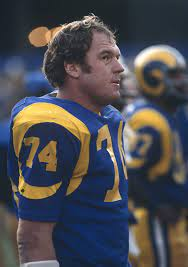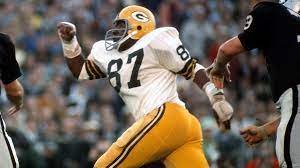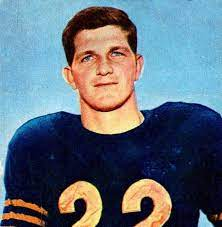Merlin Jay Olsen was an American football player, announcer, and actor. For his entire 15-year professional football career he was a defensive tackle with the Los Angeles Rams in the National Football League. He was selected to play in the Pro Bowl 14 times, every year but his last. The only other football players to have matched or exceeded that number are the former offensive lineman Bruce Matthews, the former tight end Tony Gonzalez, the former quarterback Peyton Manning, and the former quarterback Tom Brady, who is the only NFL player to have played more times in the Pro Bowl, with 15 selections.
In 1961, Olsen received the Outland Trophy, awarded to as the best lineman of the year in college football. He is a member of the Pro Football Hall of Fame and the College Football Hall of Fame. As an actor, he portrayed a farmer, Jonathan Garvey, on Little House on the Prairie. After leaving that series, he starred in his own NBC drama, Father Murphy.
Coming out of college, Olsen had offers from both the Los Angeles Rams of the National Football League and the Denver Broncos of the rival American Football League. He chose the security of the NFL and signed with the Rams. Olsen's first contract was for around $50,000 for two years, plus a signing bonus. It was 1962, and the average football player salary at the time was around $12,000 a year. He was the first USU Aggie to be drafted in the 1st round of the NFL draft.
Olsen played professionally (1962–1976) for the Los Angeles Rams of the National Football League. A leading defensive star of his era, he missed only two games in his 15-season NFL career. He was named the NFL's Rookie of the Year in 1962 and was First-team All-Pro in 1964, and 1966 through 1970. He was voted Second-team All-Pro in 1965, 1973 and 1974.
Olsen almost ended up on offense, but was later moved to the defensive line after a few experiments in practice. Soon he became part of one of the best front fours in NFL history. Deacon Jones, Rosey Grier, and Lamar Lundy joined Olsen on the defensive line in 1963 that was nicknamed "The Fearsome Foursome". He was named the AP NFL Defensive Player of the Week for week 12 in 1965. Olsen scored his first touchdown in that game.
Throughout the 1960s, this quartet terrorized opposing offenses. Olsen's play helped the Rams to the playoffs in 1967 and 1969. He was voted the club's Outstanding Defensive Lineman from 1967 to 1970 by the Los Angeles Rams Alumni. In week 14, 1967, Olsen and the rest of the Fearsome Foursome were named the AP NFL Defensive Players of the Week for their performance against the Baltimore Colts. In the 1970s, Olsen continued his dominant play at defensive tackle and his 11 sacks in 1972 were second on the team. After week 8 in 1972, Olsen was named the Associated Press NFL Defensive Player of the Week for the third time in his career.
The Rams won the NFC West crown in 1973 through 1976 thanks in part to the play of Olsen. They ranked first in the NFL in run defense in 1973 and 1974 and finished second in sacking opposing passers both years. In 1973 Olsen was voted the NFLPA NFC Defensive Lineman of the Year and the next season, 1974, he was the recipient of Bert Bell Award as the NFL MVP as voted by the Maxwell Club. Olsen accepted the award "on behalf of all who toil in the NFL trenches".
Three of the Olsen brothers, Merlin, Phil, and Orrin, played in the NFL, with Merlin and Phil playing together for the Rams from 1971 to 1974. A nephew, Hans, son of his brother, Clark, also played professional football. In 1975 and 1976, the Rams defense finished second in the NFL against the run while ranking in the top five in sacking opposing quarterbacks and compiling a 22-5-1 record over those two seasons.
Olsen's last game was the NFC Championship game in 1976 at Bloomington, Minnesota. The Vikings took advantage on a freak play early in the game. A blocked field goal returned 90 yards for a touchdown shocked the Rams in the first quarter. The defense was later victimized by a couple of big plays by the Vikings. The Rams came up short, losing 24–13, bringing the storied career of the Rams' finest defensive tackle to an end.
Olsen made the Pro Bowl a then-record 14 times, missing it only in his final year. He was inducted into the Pro Football Hall of Fame in 1982 in his first year of eligibility; he selected his college position coach Tony Knap as his presenter. In 1999, Olsen was ranked 25th on The Sporting News' list of the 100 Greatest Football Players.
Olsen enjoyed continued success after the NFL as a broadcaster, actor, and businessman.
Olsen served as a television color commentator, teaming mostly with Dick Enberg on NBC's coverage of the AFC during the late 1970s and almost all of the 1980s. He and Enberg also teamed for four Super Bowls (XV, XVII, XX and XXIII), as well as nine Rose Bowls from 1980 to 1988. Olsen also worked Super Bowl XIII in 1979 with Curt Gowdy and John Brodie (Enberg was then serving as pre-game/halftime/post-game host). In 1989, Olsen was replaced by[16] Bill Walsh as NBC's lead NFL color commentator. For the 1989 season, Olsen worked with Charlie Jones on NBC's broadcasts. In 1990 and 1991, he moved to CBS Sports doing NFL games with Dick Stockton.
Olsen developed a successful career as an actor. He appeared as the character Little George in the John Wayne movie, The Undefeated, with Rams teammate Roman Gabriel, in 1969.
In 1970, he appeared once on Petticoat Junction, in the episode: "With This Ring". He played mountaineer Merlin Fergus.
When Little House on the Prairie actor Victor French left to star in his own comedy Carter Country in 1977, Olsen was tapped to play Michael Landon's new sidekick Jonathan Garvey for several years. One memorable quote from his character's son, Andy Garvey, "My pa doesn't know anything about football!" came when Andy's friends suggested that Jonathan coach their football team.
Olsen played the starring role of John Michael Murphy in the 1981-83 NBC television drama series Father Murphy.
In the Highway to Heaven episode 2.12 ("The Good Doctor"), the main character, Alex, tells Mark Gordon (Victor French) that "All I could see was the flowers and the beard. I thought you were Merlin Olsen." This is an inside joke since all three actors, Merlin Olsen, Michael Landon, and Victor French were in the TV series Little House On the Prairie earlier in their careers.
Olsen's last acting work was in the short-lived 1988 TV series Aaron's Way.
Olsen was also the commercial spokesman for FTD Florists for many years. A part-time resident of the Coachella Valley, Olsen was the longtime radio and television spokesman for Palm Desert-based El Paseo Bank.
Olsen also appeared in many Sigma Chi fraternity promotional campaigns; Merlin, along with his brother Phil, was a Life Loyal Sig, Significant Sig (given to members for distinguishing acts outside the fraternity) and a member of the Order of Constantine (given for service to the Fraternity). Olsen donated one of his cleats, which were bronzed, to be used during the annual football rivalry between two Las Vegas high schools, Eldorado High School and Chaparral High School, which both opened in 1973. Each year, Olsen presented the "trophy" in the ceremony at the rivalry game.[citation needed]
Olsen often co-hosted the Children's Miracle Network telethons, a humanitarian organization founded in 1983 by Marie Osmond and John Schneider.
He was named the Walter Camp Man of the Year in 1982 and Athlete of the Century for the state of Utah. During halftime of a basketball game between Utah State, Olsen's alma mater, and Saint Mary's on December 5, 2009, Utah State University announced that the playing surface inside Romney Stadium, home stadium for the university's football program, would be named Merlin Olsen Field in Olsen's honor. Because of Olsen's illness, Utah State decided not to wait until the 2010 football season to hold the ceremony; he was able to attend the game, but did not speak. A sculpture of Olsen was unveiled in a plaza south of the stadium during an official dedication ceremony in Fall 2010.
In 1979, Olsen was inducted into the Utah Sports Hall of Fame. In 1980, Olsen was inducted into the National College Football Hall of Fame. In 1998, Olsen was inducted into the Utah Tourism Hall of Fame. Olsen was voted to the California Sports Hall of Fame Class of 2010, along with Bill Walton, Dwight Stones, and Jim Otto, among others. In 1983, Olsen served as Grand Marshal of the Rose Parade.
Sources
https://www.pro-football-reference.com/
https://www.profootballarchives.com/index.html
https://americanfootballdatabase.fandom.com/wiki/Football_Wiki
https://www.gridiron-uniforms.com/GUD/controller/controller.php?action=main
https://www.profootballhof.com/hall-of-famers/
Florio, Mike (March 11, 2010). "Reports: Merlin Olsen dies at 69". ProFootballTalk. NBC Sports. Retrieved March 11, 2010.
Cox, Erin (January 13, 2017). "Magic Merilin". The Herald Journal. Retrieved November 18, 2019.
Honorary Degree Recipients Utah State University.
"Merlin Olsen College". Lowongankerja2010x.com. Retrieved March 12, 2010.[dead link]
"Utah State University Media Guide" (PDF). Archived from the original (PDF) on March 4, 2016. Retrieved May 4, 2007.
"Utah State Championships". College Football Data Warehouse. Archived from the original on February 16, 2010. Retrieved March 13, 2010.
The East West Shrine Game | Hall of Fame Archived July 21, 2009, at the Wayback Machine
Hula Bowl | History Archived July 14, 2007, at the Wayback Machine
NEA All-Time All-America Team – Beckly Post-Herald, August 24, 1969
"Utah State's Merlin Olsen Named To 75th Anniversary All-Sun Bowl Team" (Press release). Utah State University. July 3, 2008. Archived from the original on November 22, 2008. Retrieved November 16, 2009.
"Utah State University Will Honor Merlin Olsen on Saturday, Dec. 5 At Aggie Basketball Game" (Press release). Utah State University. November 16, 2009. Retrieved March 11, 2010.
2008 St. Louis Rams Media Guide
"Merlin Olsen - enshrinement speech - 1982". profootballhof.com. Retrieved March 25, 2012.
"NFL News, Scores, Schedule & Standings - Pro Football". Sporting News. Archived from the original on March 9, 2010. Retrieved March 13, 2010.
"BREAKING NEWS: The Fearsome Foursome now two: NFL Legend Merlin Olsen Dead at 69". The Enterprise Report. March 11, 2010.
"History of #1 analyst demotions". Classic Sports TV and Media. February 18, 2013. Retrieved April 13, 2013.
"The Desert Sun - Palm Springs and Coachella Valley news". Desert Sun.
Ray Brewer (March 11, 2010). ""Merlin Olsen's death felt at Eldorado, Chaparral"". Las Vegas Sun. Retrieved January 8, 2020.
"Olsen, Hall of Famer and member of 'Fearsome Foursome' dies". NFL News. Associated Press. March 11, 2010. Archived from the original on August 29, 2010. Retrieved March 11, 2010.
Harrison, Shawn (December 6, 2009). "Field named after Olsen: Utah State honors Aggie legend in halftime ceremony". The Herald Journal. Logan, Utah. Retrieved July 14, 2018.
"Honorees – Utah Sports Hall of Fame Foundation".
"Merlin Olsen (1980) - Hall of Fame".
"Tourism Hall of Fame".
"2010 Inductees". California Sports Hall of Fame. Retrieved July 14, 2018.
"Mediterranean Estate, San Marino, California 1984". glen-hampton-gardens-designs.com. Archived from the original on January 26, 2020. Retrieved August 20, 2019.
"Hans Olsen Stats, Height, Weight, Position, Draft, College". Pro-Football-Reference.com.
Eborn, Jared (December 6, 2009). "Utah State football names field after Merlin Olsen". Deseret News. Salt Lake City. Archived from the original on December 8, 2009.
"Merlin Olsen suing NBC". TV Squad. December 31, 2009. Retrieved March 11, 2010.
"Mesothelioma Takes Life of Merlin Olsen". March 12, 2010. Archived from the original on March 5, 2016. Retrieved March 12, 2010.
Thursby, Keith (March 12, 2010). "Merlin Olsen dies at 69; Hall of Fame football star later became actor". Los Angeles Times. Retrieved March 12, 2010.
Goldstein, Richard (March 11, 2010). "Merlin Olsen, 69, Football Star, Commentator and Actor, Dies". The New York Times.





















